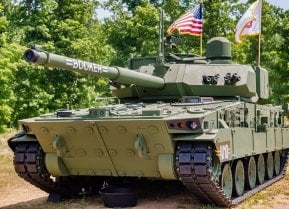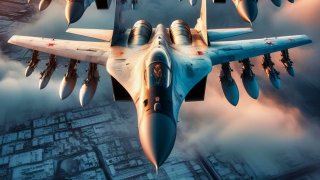Just Ask Ukraine: Is the Russian Military a Paper Tiger?
The Russian military has managed to somewhat flip the tables in Ukraine. Acute shortages in ammunition – particularly artillery rounds – have made the Ukrainian forces much weaker. As a result, the Russian forces have been gaining ground in eastern Ukraine and the Donbas. The trajectory of the conflict shows that the Russian military can withstand some serious punishment for long periods.
Summary: Over two years into its large-scale invasion of Ukraine, questions about Russia's military capabilities and its status as a near-peer threat to the United States remain pivotal. Despite suffering significant personnel and equipment losses—estimated at over 300,000 casualties and thousands of heavy combat vehicles—the U.S. Intelligence Community's annual threat assessment details a multi-year recovery path for the Russian military.
Russia's Military: Just How Powerful?
More than two years after the whole-scale invasion of Ukraine, is Russia still a near-peer threat to the United States? What are the capabilities of the Russian military after 24 months of heavy fighting against a determined Ukrainian military equipped with Western weapon systems? How soon can the Russian armed forces replenish the devastating losses they have been taking in the fighting? These are just some of the questions the U.S. Intelligence Community analyzes in its latest annual threat assessment.
Released every year in early spring, the annual threat assessment delves into the most acute threats to U.S. national security and projects how these issues will affect America.
China remains at the forefront of threats to the United States. In the long term, Beijing will challenge U.S. supremacy not just in the Indo-Pacific but also around the world. But on a more short-term, but still important, level, Moscow continues to directly threaten the U.S. and NATO in an attempt to gather leverage in Europe and elsewhere.
THE RUSSIAN MILITARY TODAY AND TOMORROW
The Russian military has lost more men than at any time since World War II. Western intelligence estimates put the number of Russian losses to over 300,000 men killed and wounded. Russia has also lost thousands of heavy combat vehicles. Until the Russian army recovers, it will fall on the Russian navy and Russian Aerospace Forces to provide some sort of global power projection capabilities.
“Moscow’s military forces will face a multi-year recovery after suffering extensive equipment and personnel losses during the Ukraine conflict. Moscow will be more reliant on nuclear and counterspace capabilities for strategic deterrence as it works to rebuild its ground force,” the Intelligence Community estimated in its annual threat assessment.
Although the Russian Ministry of Defense has announced plans to enlarge the military, it will take the Kremlin years to rebuild its previous combat capacity, let alone enlarge it. And it’s not just about numbers – rather, to increase its capabilities, the Russian military will need modern weapon systems and to provide adequate training to its soldiers.
“Moscow’s announced plans to massively expand its ground forces almost certainly will fall short, but nonetheless will over time result in a larger even if not qualitatively better military,” the Intelligence Community assessed.
The Kremlin is pouring big bucks on its military, offering significant pay and benefits to attract more men to enlist. It also has a national service system that provides more troops, though of questionable quality.
But the Kremlin is also relying heavily on private military companies to achieve its ends, and the U.S. Intelligence Community assesses that it will continue to do so even without the powerful Wagner Group mercenary group in the picture.
“Russia will rely on private military and security companies (PMSCs) and paramilitary groups to achieve its objectives on the battlefield in Ukraine, to augment Russian forces, to move weapons and to train fighters, to hide Moscow’s hand in sensitive operations, and to project influence and power in the Middle East and Africa,” the annual threat report stated.
NUCLEAR WEAPONS
When it comes to nuclear weapons, Russia poses the biggest threat to the United States. Moscow has the largest nuclear arsenal in the world, with approximately 5,600 nuclear warheads spread across its submarines, strategic bombers, and land-based systems – what is called the nuclear triad. Despite setbacks in Ukraine, the Russian military continues to spend money and resources on its nuclear arsenal.
“Moscow will continue to develop long-range nuclear-capable missiles and underwater delivery systems meant to penetrate or bypass U.S. missile defenses. Russia is expanding and modernizing its large and diverse set of nonstrategic systems, which are capable of delivering nuclear or conventional warheads, because Moscow believes such systems offer options to deter adversaries, control the escalation of potential hostilities, and counter U.S. and Allied conventional forces,” the Intelligence Community assessed.
STRATEGIC LESSONS FROM RUSSIA’S WAR IN UKRAINE
The Russian military has managed to somewhat flip the tables in Ukraine. Acute shortages in ammunition – particularly artillery rounds – have made the Ukrainian forces much weaker. As a result, the Russian forces have been gaining ground in eastern Ukraine and the Donbas. The trajectory of the conflict shows that the Russian military can withstand some serious punishment for long periods. Russia’s political system facilitates this capacity to endure losses and operational setbacks. Thus, in a potential war with Russia, the U.S. and NATO would have to account for an adversary that could bounce back from what would otherwise have been catastrophic failures and miscalculations.
Sanctions, moreover, have had a limited impact on the ability of the Russian military to wage a prolonged, large-scale campaign. The Kremlin has managed to outsource certain needs – such as unmanned aerial systems and artillery production – to allies and partners, even relying on pariah states like Iran and North Korea to do so.
About the Author
Stavros Atlamazoglou is a Greek Army veteran (National service with 575th Marines Battalion and Army HQ). Johns Hopkins University. You will usually find him on the top of a mountain admiring the view and wondering how he got there.
This article was first published by Sandboxx News.


